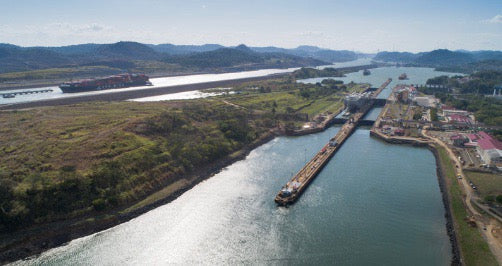
Panama Canal: Transition & Commitments
Share
American Commitment
The original purpose of the Panama Canal was to create a strategic waterway that connected the Atlantic and Pacific Oceans, significantly reducing travel time for maritime trade routes, and enable two American naval fleets (Atlantic & Pacific). The United States allocated approximately $375 million to the construction of the canal, a substantial amount in the early 20th century. Adjusted for inflation, this investment would equate to nearly $10 billion in today’s dollars. This financial commitment reflects the importance placed on the canal as a critical infrastructure project to bolster global trade and U.S. maritime dominance.
From its opening in 1914 until 1979, the United States played a pivotal role in the operation, maintenance, and security of the Panama Canal. Thousands of U.S. citizens and military personnel were stationed in the Canal Zone, a 10-mile-wide strip of land surrounding the canal. This area, under U.S. jurisdiction, ensured smooth operations and safeguarded the canal from external threats. The U.S. government maintained a steadfast commitment to the canal’s efficiency, highlighting its vital role in global trade and U.S. strategic interests.
Panama: 1964 to 1979
The period between 1964 and 1979 saw increasing tensions in Panama over U.S. management of the canal and presence in the Canal Zone. The Panamanian riots of January 9, 1964, were a turning point. Over this time period, events escalated into widespread protests and violence, fueled by Panamanian demands for sovereignty over the canal. Influential figures, such as Panamanian leader Omar Torrijos, became central to the movement advocating for national control.

In response to growing unrest, Jimmy Carter initiated negotiations with Panamanian leadership after he attained the presidency. These talks culminated in the signing of the Torrijos-Carter Treaties in 1977, which outlined the gradual transfer of the canal to Panama by the end of the century. The treaties emphasized cooperation, and attempted to establish clear conditions that would ensure the canal's continued operation and its neutrality during and after the transition.
Panama: 1979 to 1999
The Torrijos-Carter Treaties took effect in 1979, marking the beginning of Panama’s incremental control over the canal. One key condition was the establishment of the Panama Canal Commission, a joint U.S.-Panamanian entity responsible for managing operations during the transition period. In exchange, Panama committed to maintaining the canal’s neutrality, ensuring its accessibility to vessels from all nations, and upholding security agreements with the United States. Questions exist whether Panama has, and continues to, meet these commitments.

Between 1979 and 1999, the canal faced challenges such as maintenance demands and disputes over toll structures. Despite these, the transition proceeded on schedule, with Panama taking full control on December 31, 1999. During this period, Panama also navigated internal political issues, including military rule, corruption and leadership changes, which occasionally impacted canal operations. During this period of instability the canal remained a vital conduit for trade.
Summary
The history of the Panama Canal highlights the significant commitments made by the United States to the nation of Panama. The United States invested heavily in its construction and operation, and supported the transition to Panamanian control under the treaty conditions. This transition underscores the importance of the canal to the United States, and a commitment for accountable and responsible management for this critical infrastructure.
WaveRocket, a business inspired by innovation and achievement, celebrates such remarkable feats through its quality apparel and insightful articles. The combination of "Wave" and "Rocket" symbolizes the blending of sea and space, representing engineering excellence and creative exploration. This commitment to ingenuity resonates in both the products and content offered.
Discover more about WaveRocket's unique designs and clever messaging by exploring their articles and tee-shirt collections. WaveRocket.
--- by Florence Csonka
